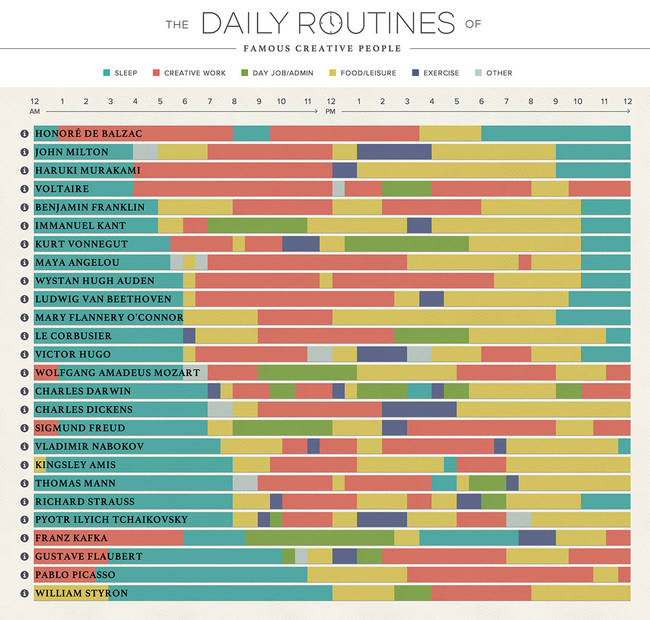Ever wonder what the secret to successful creativity is? In a world where every other Facebook post is the one from that well-meaning-but-kinda-clueless friend about the 37 habits of highly creative people, the piles of contradictory and sometimes downright incorrect information can seem hopeless. Are you supposed to get up early or stay up late? Are you supposed to buckle down and work for hours at a time or take breaks throughout the day?
Well, it turns out, you should probably just do what you like. A handy infographic, based on the work of Mason Currey, shows the average daily routines of famous writers, composers, painters, and thinkers from years past, with all of their activities broken into color-coded segments so we can see when they worked, when they played, and when they slept. The information was collected from various journals, letters, and other surviving documents of their day-to-day lives.
(via Colossal)
As you can see, the habits vary from person to person. Everyone seems to like their food and leisure time, and they are all mostly diurnal. Other than that, it doesn’t seem as though sleeping in or popping out of bed at the crack of dawn seems to matter. You’ll also see that the “day job” option isn’t too common, but this could also have to do with differences in time periods. Really, the major thing these people have in common is that they documented their daily routines and seemed to stick to them, so maybe that’s where the secret lies.
Maya Angelou
John Milton
Flannery O’Connor
Franz Kafka
This is the only infographic so far, but we’d like to see one with some 21st-century creatives, to see how modern life has affected creative routines, as well as a more diverse list of creative types. In the meantime, I’ll continue to marvel at the fact that William Styron has my ideal schedule and that Voltaire probably needed more sleep. On the site, you can also hover over the individual sections to learn about the specifics of their days–like Victor Hugo’s 11am rooftop ice baths.
 share
share
 share
share
 share
share
 share
share
 share
share



